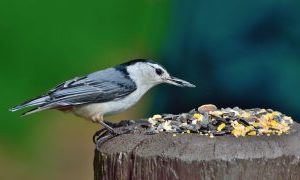 The days are getting longer, and the Northern Cardinals and American Robins are singing up a storm! Things start getting busier in March in the bird world as our year-round-resident cavity-nesting species start courtship and breeding behaviours.
The days are getting longer, and the Northern Cardinals and American Robins are singing up a storm! Things start getting busier in March in the bird world as our year-round-resident cavity-nesting species start courtship and breeding behaviours.
Male songbirds use song to define and defend their territories, as well as to attract females. Woodpeckers use drumming for this purpose, and our 3 local resident woodpecker species, the Hairy, Downy, and Pileated, will start drumming this month. The drumming of the Hairy and Downy Woodpeckers is fast and difficult to distinguish by ear. The drumming of the Pileated Woodpecker is slower and louder. From a distance, it sounds to me like the creaking ropes and wood of an old pirate ship. You may also hear slower, more deliberate tapping and piles of fresh wood chips near the bases of trees as they work away on their 2020 nesting cavities.
Black-capped Chickadees will start singing their loud, rich, whistled “Spring’s here!” or “Cheese-bur-ger!” and both nuthatch species will start calling. Chickadees excavate their nesting cavity each year, but they carry the chips away and ditch them somewhere else to help keep the location of their nest less obvious to predators. Red-breasted Nuthatches, who prefer conifers, sound like tiny plastic toy horns. Their cousins, White-breasted Nuthatches, who prefer deciduous trees, produce a loud, nasal “Hank! Hank!” or “Nut-hatch! Nut-hatch!” They also often make a quiet, squeaky, peeping sounds as they move around in the trees.
This behaviour takes a lot of energy, so it’s a great time to support them with feeders that are well-stocked with high-quality food. Chickadees and nuthatches love black sunflower seeds (hulled makes it easier for them), and the woodpeckers enjoy suet. As we described in last month’s newsletter, we carry a selection of squirrel-proof suet feeders.
Another way to help the cavity nesters is to avoid cutting down dead trees in your yard. Their limbs may need to be removed for safety reasons, but if you leave the trunk, it will provide insects for food and potentially a place to excavate a nest in years to come.
As March progresses and April approaches, more bird species will get busy, making March a great time to get your feeders cleaned and filled and perhaps install a pole system and put up some bird houses.
